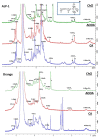An Acid-Free Alternative to Pectin Production from the Cell Walls of Olive Oil Waste and Different Fruits Using Choline Chloride
- PMID: 38002223
- PMCID: PMC10670671
- DOI: 10.3390/foods12224166
An Acid-Free Alternative to Pectin Production from the Cell Walls of Olive Oil Waste and Different Fruits Using Choline Chloride
Abstract
The pectin from the cell walls of olive waste (alperujo) and apple, orange and strawberry fruits was extracted using choline chloride (ChCl) and the yield and chemical and structural compositions were compared to pectin extracted using citric acid (CA) and ammonium oxalate/oxalic acid (AOOA). According to the results, the alperujo pectin extracted using ChCl from alcohol-insoluble residue (AIR) showed a higher yield (2.20-2.88% on the basis of dry weight of AIR) than using CA (0.65-1.22%) but lower than using AOOA (3.92-5.42%). For fruit pectin, the highest yield was obtained using CA (8.81-16%), followed by AOOA (5.4-6.63%), although for apple pectin, ChCl gave a similar yield (5.36%) to AOOA. The uronic acid contents in all ChCl pectins (45.9-70.6% dry basis AIR) were higher or similar to that of the other extracting agents (30.6-65.2%), although a lower level of neutral sugar side chains was detected, with a lower degree of branching and degree of methylation. The NMR and FT-IR spectroscopy of the pectin isolated using ChCl confirmed its slightly different structural composition with respect to CA and AOOA pectin. Therefore, depending on the source material and functionality, pectin isolated using ChCl could be an acid-free alternative to pectin production.
Keywords: NMR and IR spectroscopy; alcohol-insoluble residue (AIR); cell wall; choline chloride; deep eutectic solvents (DES); pectin.
Conflict of interest statement
The authors declare no conflict of interest.
Figures




Similar articles
-
The effect of sonication-synergistic natural deep eutectic solvents on extraction yield, structural and physicochemical properties of pectins extracted from mango peels.Ultrason Sonochem. 2022 May;86:106045. doi: 10.1016/j.ultsonch.2022.106045. Epub 2022 May 20. Ultrason Sonochem. 2022. PMID: 35617886 Free PMC article.
-
Extraction of polyphenols associated with pectin from olive waste (alperujo) with choline chloride.Food Chem. 2023 Sep 1;419:136073. doi: 10.1016/j.foodchem.2023.136073. Epub 2023 Apr 5. Food Chem. 2023. PMID: 37030208
-
Comparison of deep eutectic solvents (DES) on pretreatment of oil palm empty fruit bunch (OPEFB): Cellulose digestibility, structural and morphology changes.Bioresour Technol. 2019 Jun;282:525-529. doi: 10.1016/j.biortech.2019.03.065. Epub 2019 Mar 15. Bioresour Technol. 2019. PMID: 30898410
-
Environmentally friendly and non-polluting solvent pretreatment of palm samples for polyphenol analysis using choline chloride deep eutectic solvents.J Chromatogr A. 2017 Apr 7;1492:1-11. doi: 10.1016/j.chroma.2017.02.036. Epub 2017 Feb 21. J Chromatogr A. 2017. PMID: 28283247
-
Production of nanocellulose using acidic deep eutectic solvents based on choline chloride and carboxylic acids: A review.Int J Biol Macromol. 2023 Aug 1;245:125227. doi: 10.1016/j.ijbiomac.2023.125227. Epub 2023 Jun 7. Int J Biol Macromol. 2023. PMID: 37290548 Review.
Cited by
-
Thermal extraction and characterization of pectin from semi-solid by-products of the olive oil industry.J Sci Food Agric. 2025 Aug 30;105(11):5863-5873. doi: 10.1002/jsfa.14316. Epub 2025 Apr 29. J Sci Food Agric. 2025. PMID: 40298173 Free PMC article.
References
-
- Voragen A.G.J., Coenen G.J., Verhoef R.P., Schols H.A. Pectin, a versatile polysaccharide present in plant cell walls. Struct. Chem. 2009;20:263–275. doi: 10.1007/s11224-009-9442-z. - DOI
-
- Ropartz D., Ralet M.C. Pectin structure. In: Kontogiorgos V., editor. Pectin: Technological and Physiological Properties. Springer; Cham, Switzerland: 2020. pp. 17–36. - DOI
-
- Maxwell E.G., Belshaw N.J., Waldron K.W., Morris V.J. Pectin—An emerging new bioactive food polysaccharide. Trends Food Sci. Technol. 2012;24:64–73. doi: 10.1016/j.tifs.2011.11.002. - DOI
-
- Liu J., Willför S., Xu C. A review of bioactive plant polysaccharides: Biological activities, functionalization, and biomedical applications. Bioact. Carbohydr. Diet. Fibre. 2015;5:31–61. doi: 10.1016/j.bcdf.2014.12.001. - DOI
LinkOut - more resources
Full Text Sources

